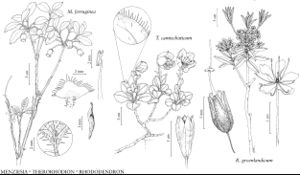Therorhodion
in N. L. Britton et al., N. Amer. Fl. 29: 45. 1914 ,.
| Taxon | Illustrator ⠉ | |
|---|---|---|
 | Menziesia Menziesia ferruginea Therorhodion Therorhodion camtschaticum Rhododendron groenlandicum | Barbara Alongi Barbara Alongi Yevonn Wilson-Ramsey Yevonn Wilson-Ramsey Yevonn Wilson-Ramsey |
Shrubs, (rhizomatous). Stems erect to sprawling or procumbent; twigs rough, with simple, long-stipitate, glandular or eglandular hairs, with or without unicellular hairs, (older twigs without peglike projections). Leaves persistent or deciduous, alternate; petiole absent or nearly so; blade membranous to chartaceous, margins entire or obscurely serrulate, fringed with eglandular or glandular-hairs; (venation brochidodromous, reticulum clear). Inflorescences terminal, reduced racemes, (each flower in bract-axil); perulae green, leaflike proximally. Flowers bisexual, bilaterally symmetric; sepals 5, slightly connate; petals 5, connate ca. 1/3 their lengths, corolla deciduous, ± rotate; stamens 10, included, (unequal); anthers without awns, dehiscent by terminal pores; ovary 5-locular; style inserted in slight depression at ovary apex, (curved, long, slender); stigma capitate. Fruits capsular, ovoid, dehiscence basipetally septicidal. Seeds ca. 50–100, (brown), ± ellipsoidal, without appendages; testa smooth. x = 12.
Distribution
Alaska, ne Asia (ne China), ne Asia (Japan), ne Asia (Korea), ne Asia (Russian Far East)
Discussion
Rhododendron Linnaeus sect. Therorhodion Maximowicz, Mém. Acad. Imp. Sci. Saint Pétersbourg, Sér. 7, 16: 47. 1870; Rhododendron subg. Therorhodion (Maximowicz) Drude
Species 3 (2 in the flora).
Therorhodion is often included within Rhododendron; cladistic analyses (K. A. Kron and W. S. Judd 1990; Kron 1997) indicate that the group lies outside the Rhododendron clade, and it was given generic status by J. K. Small (1914), H. F. Copeland (1943), P. F. Stevens (1971), Kron et al. (2002), and Stevens et al. (2004).
Plants of Therorhodion from the Aleutian Islands and the southern coast of Alaska have leaves that lack or have only sparse stipitate-glandular hairs, and corolla lobes that are hairy outside. In contrast, plants from the Seward Peninsula and lower Yukon River valley have leaves that are obviously glandular-hairy and corolla lobes that are glabrous outside. These two morphological entities often have been recognized as varieties or subspecies (W. R. Philipson and M. N. Philipson 1986; E. Hultén 1927–1930, 1968); they do not intergrade (at least in North America) and are recognized here as distinct, allopatric species. The taxonomy of this group will remain tentative until the genus is revised using modern methods. The third species of the genus, T. redowskianum (Maximowicz) Hutchinson occurs in eastern Asia.
Selected References
None.
Lower Taxa
Key
| 1 | Leaf blades (of vegetative branches) eglandular or sparsely glandular-hairy; outer corolla surface hairy, lobe margins ciliolate | Therorhodion camtschaticum |
| 1 | Leaf blades (of vegetative branches) glandular-hairy; outer corolla surface ± glabrous, lobe margins smooth. | Therorhodion glandulosum |
"/3" is not declared as a valid unit of measurement for this property.